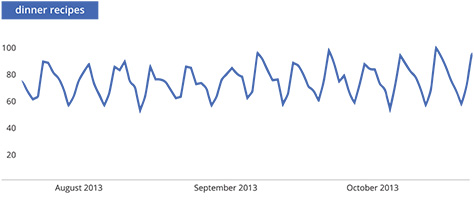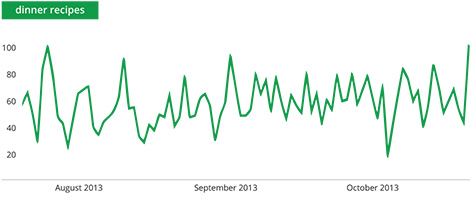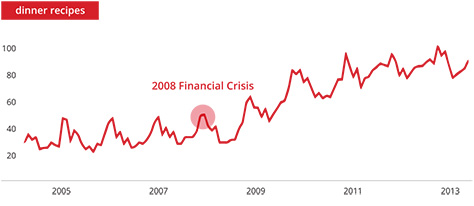Search is often the first place we go for information - across topics, time periods, screens and situations. This fuels an ongoing collection of data that can reflect back our collective thoughts and interests like no other medium can. It's the world's largest consumer panel, one that's uniquely vast, timely and authentic. For brand marketers, it's a potential gold mine. There are fascinating insights to be discovered - about consumers, brands, industries, companies, culture - through readily-available search data. In a series of articles, we'll explore how. Here, we start with why.
What was your last search? When did you do it?
If you're like me, you're searching for all kinds of things at all hours of the day. My last search was for good apple pie recipes. I'd just come into 10 pounds of apples. How? That's a larger story, which also started with search. The week before, I was planning a weekend trip. I did some searching on 'weekend activities' and landed on "Best Apple Picking in the Boston Area". Once I searched to get the weather forecast (sunny), I looked for the best orchards that also had organized events (and a corn maze). I finally decided on one in Stowe, Massachusetts, then searched for driving directions to get there.
There's nothing remarkable about this story itself; we all do similar things every day. But that's the point. Search is powering these stories across millions of queries each day. It's arguably the first place we go to for information —across topics, across time periods, across screens and situations. Living without search deprives us not only of efficiency, but a real sense of empowerment. In many ways, it's the historian of our uniquely personal life stories. Those stories can happen in a single chapter, or they can create a whole novel — captured in bursts and spanning anything from minutes to days to months.
There is search advertising, and there is search behavior. Today, marketers need to harness the power of both.
All this searching generates tremendous amounts of data that can reflect back our collective thoughts and interests like no other medium can — creating an engine of marketing insights that can surface fascinating things about people, brands and industries. Yet, while many marketers see search as a way to directly connect with consumers seeking what they have to offer, they often overlook the power of this inbound 'insights' piece. In other words, there is search advertising, and there is search behavior. Today, marketers need to harness the power of both.
The largest consumer panel
Studying search patterns — not just the 'what' but also the 'where' and 'how' — gives a unique window into consumers, categories and cultural trends — one that has historically been difficult to obtain. Why? The power lies in the numbers. There are more than a billion Google searches each day, and an active user searches on average 25 times per day.1 We also know that 15% of daily searches are new, indicating that while the behavior is routine, the topics and phrasing are often unique.2
This essentially makes search data the largest consumer panel on record (representing the entire 2.5 billion user population of the Internet). It's a vast virtual library of anonymized behavior data that can significantly augment the current methods brands use to learn about their consumers.
With this amount of consumer data, we can delve into topics to explore patterns that exist at large, or slice the data by time or place to zoom into specifics. Let's take a basic example — from which it should be easy to see the broader brand applications.
We can quickly discover that searches for "dinner recipes" spike on Sundays in the U.S., while they dip on Fridays and Saturdays. This makes complete sense when we think about the life of a working American —many are thinking about the meals they'll prepare for the week. Armed with this information, a marketer might decide to invest more heavily in media over the weekend to keep their ingredients/products/recipes in the consideration set.
Exploring a topic relevant to your category
Indexed Search Query Volume, United States

The size of the search panel also enables various views of the data, including by geographic areas. For example, focusing the same 'dinner recipes' query within New York City (and other large metro areas) shows more variation in search patterns, without the prominent weekend spikes. This suggests that marketers may want to think differently about the 'cooking at home' messages they deliver to big cities vs. the general population. For example, their creative might emphasize weekend cooking for the general public versus a focus on easy weekday dinners for urban areas.
Identifying geographic patterns
Indexed Search Query Volume, New York City

If we pull back to the U.S.-wide view, expanding the time period to 2006 through 2013, we can extrapolate a broader trend around growing interest in home cooking — possibly related to health concerns and economic changes. In fact, the post-2008 financial crisis time period shows a trend of accelerating interest in home cooking — a macro trend that might guide new products or an evolution in messaging.
Zooming out to explore macro trends
Indexed Search Query Volume, United States

The bottom line is that search-driven insights are not just interesting, they're also actionable. Marketers can use them to inform decisions about a wide variety of topics — from investing in products or content aligned with trending categories (such as home cooking), to adapting creative messaging by geographic areas (such as different messaging for NYC vs. other areas), to flighting or augmenting media spend to align with search patterns, and more.
While 'dinner recipes' was just one example, you can begin to consider the application of similar signals in a multitude of industries: Consumer Packaged Goods, Retail, Auto, Food & Beverages, etc. Search acts as a massive panel of consumers across them all, with massive potential to guide decisions.
An immediate, ongoing pulse
Not only is search data powerful due to its scale and the ability to reveal insights across various dimensions, but it's also powerful due to its immediacy — immediacy in capture, and immediacy in access.
Search captures dynamic consumer behavior in the moment. That's especially true since search is no longer a desktop-only activity; it's an always-accessible sidekick. Mobile devices have given us the ability to search whenever and wherever we want to. This shift to constant connectivity means people weave in and out of "search mode" effortlessly, turning reflexively to whichever device makes the most sense in the moment. There's no need to wait; what's on the mind now can be searched for. This merely expands search's window into the public's "mind" as more aspects of consumer stories are captured, more often, at the moments that matter. This is feeding an even richer understanding of what they're thinking and doing throughout their busy days. There's no time of day when search isn't capturing a signal.
The data from search is also available to marketers extremely quickly. Many insight-gathering methods (such as 3rd party research) involve considerable lag time, but with search there's no need to wait for the pulse of consumer behavior and sentiment to be packaged for use. It's delivered in an ongoing way, day after day, with incredible recency. This lends marketers the ability to stay tapped into consumer interests as they are revealed, and the ability to quickly flag new or trending opportunities.
Hot Searches is a great way to explore the real-time nature of search data. It surfaces the trending topics that are spiking as recently as a half-hour ago, across many categories: news, events and cultural changes to name a few. We can also quickly see what's driving that consumer interest, the results of which can sometimes be quite surprising...
Truth in numbers
Marketers can also feel confident that search data is truly representative and unbiased. This goes beyond its representativeness due to size and scope (i.e. over a trillion searches per year3 across 146 languages). It's equally powerful because the insights are honest and authentic. No one holds back —nor exaggerates — when 'searching' for something. In fact, it can be argued that some of the most intimate and truthful dialogue goes on in the Google Search Box.
Today many marketers are harnessing data from social media to capture quick insights from a live environment that avoids various inherent biases and timing challenges of focus groups and 3rd party research. However, this social data has its own bias — one of sampling. It typically represents the outliers that want to broadcast their opinions publicly, often reflecting extremely positive or extremely negative thoughts and opinions. Search, on the other hand, is not about sharing with others. It's about personal curiosity and intentions. So when we search, we're candid, direct and uncensored.
A brand planning power tool
While current planning methods and insights tools such as focus groups, 3rd party research, and social listening can deliver some valuable insights, anonymized search data can add tremendous value to augment them. Its unique combination of attributes (i.e. the scale, immediacy, authenticity) captures and delivers a true pulse of attitudes and intentions in a timely and ongoing way. This is what makes search data an exciting and useful tool for marketers — for monitoring and discovering trends, and for orienting planning efforts toward new and innovative ideas. It's time to start your engine of insights.
This is just the first in a series of articles on search insights. In the coming weeks, we'll be exploring more specific applications for this data that can have an immediate impact on your business, including tapping into the cultural zeitgeist, investigating brand associations, evaluating the competitive landscape and more.







